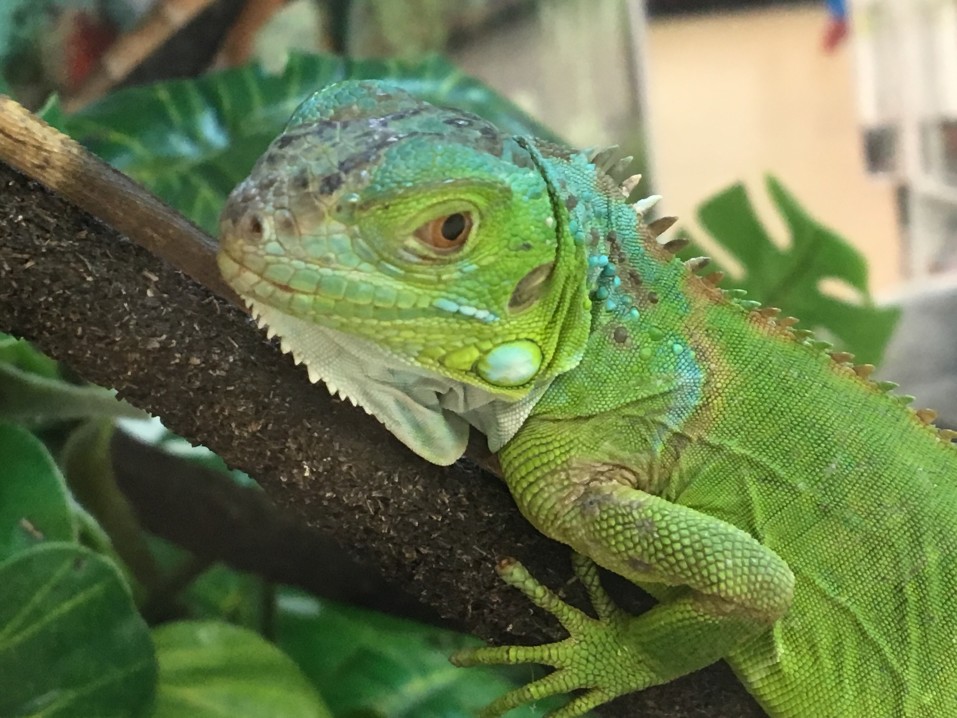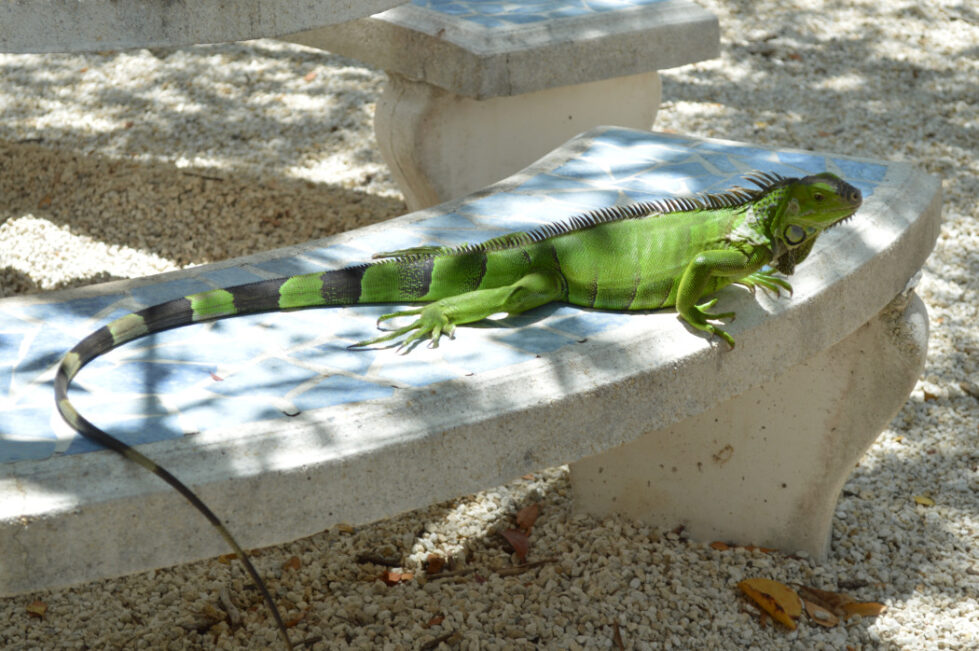How to Remove Iguanas
If you live in the southern states, iguanas can wreak havoc on your garden and the vegetation around your home. Flowers, plants, and fruits are eaten by these reptiles. They have the potential to destroy ornamental plants near your home. As a result, it’s critical to understand how to get rid of iguanas.
These reptiles are extremely fast and difficult to catch by hand. Using simple chemicals is also risky because they can harm garden plants or pets. I’ve spent a long time looking for better ways to get rid of iguanas in the yard, and I’ve finally found one.
Green Iguana Identification
Green iguanas are large, typically green lizards that can also be brown or nearly black in color. During certain times of the year, some adults can turn orange or pink. Hatchling and young green iguanas are typically bright green in color. Green iguanas have dark black rings on their tails and a row of spikes down the center of the neck, back, and upper portion of the tail.

Iguanas are plant-eating reptiles native to South America and the southern United States. They prefer a hot, humid climate. They are most common in Texas, Florida, and Hawaii in the United States.
On the surface, they appear to be ordinary green lizards up to 1.5 meters long (including the tail). An adult’s body length is typically 11-13 inches, with a weight of 8-9 lbs. Reptiles have a scaly ridge on their upper body along the ridge.
What Attracts Iguanas to Your Property?
To practice iguana control, you must first understand how they live and eat. So, what exactly do iguanas eat? These reptiles do not eat insects and are not dangerous to humans or pets. Even if they are agitated, they will not bite.
Iguanas eat leaves from trees and bushes, as well as flowers and some fruits. As a result, if these reptiles get into your garden, it could be destroyed. Figs, strawberries, hibiscus, tomato fruits, plums, apricots, peaches, incense leaves, and various flowering shrubs attract them.
Green iguanas eat shoots, leaves, blossoms, and fruits from plants such as nicker bean, firebush, jasmine, orchids, roses, Washington fan palms, hibiscuses, garden greens, squashes, and melons. Because of their proclivity to eat ornamental plants, they can be a nuisance to homeowners. Adult green iguanas will eat bird eggs and dead animals. Green iguana juveniles eat vegetation, insects, and tree snails.
Many details in yours may attract these herbivorous reptiles from the nearby rainforest or park. They prefer overgrown, shady areas with high humidity levels. The iguana will be attracted to your property if there are such unruly areas nearby with bushes and trees.
Iguanas can detect the aroma of ripe fruits from a great distance. Iguanas cannot be kept away from plants unless special deterrent products are used. It’s nearly impossible to get rid of them with simple chemicals or by cleaning the area; you’ll have to be diligent to get rid of them permanently.
Iguana Control Tips: How to Prevent Iguanas
Here are a few tried-and-true methods for keeping iguanas away from your plants:
• Run a wire around the perimeter of the garden to keep reptiles out.
• Clear the garden of dense shrubs and trees that are not exposed to sunlight (this will also help keep snakes at bay during the rainy season);
• To avoid attracting reptiles, vegetable plantations should be grown in a closed greenhouse.
• Remove logs, canoes/boats, cars, stones, and other large objects that can be used as a hiding place for iguanas and snakes.
• Iguanas eat fruits and plants, which helps to identify them. You’ll notice a large iguana nearby sooner or later as you walk around the garden.
Keeping Iguanas Away
Are you looking for a way to keep iguanas away from your plants and home? Check your garden for any rotten fruits that have fallen. Collect the fruits from the trees at the appropriate time. Wait until tomatoes and other vegetables begin to rot and fall to the ground before taking action.
If the trash can is not tightly closed, some reptiles can climb right into it. Close the trash can lid or place something heavy on top of it to prevent reptiles from getting in and eating waste.
Because of the iguana’s constant invasion, you can transplant plants in your garden. Use iguana-resistant plants like crotons, Ixora, oleander, milkweed, and citrus for this.
How to Remove Iguanas
A clean environment is the best deterrent for an iguana. Installing mesh or other deterrents is a common treatment, but it is not always effective in keeping iguanas away from plants. You may need to hire pest control experts or iguana trappers on occasion. If you have a problem with multiple iguanas or an infestation, you should contact a wildlife removal specialist who is specialized in iguana control.
Iguana Repelling Devices
A specially designed electrical grid around the perimeter of your yard or garden for small reptiles and various mammals is a good first choice. You can also use mechanical traps as an alternative.
Many homeowners use liquid iguana deterrents to keep iguanas away. Using repellents is one of the most effective ways to get rid of an iguana invasion in your yard. Reptiles are not killed or harmed by a special liquid. They flee as soon as they smell this liquid and never return.
This is convenient because you don’t have to dispose of the dead bodies of iguanas or transport the caged reptiles somewhere in the forest.
Iguanas will burrow and dig holes. Look for holes in the ground around your house. Snake and reptile caves are very similar, so be cautious. Fill large holes with fine gravel if you find them.
Because of the hard rock, the iguanas will be unable to dig it. Iguana eggs may be found in the burrows, as these reptiles can lay up to 76 eggs. Before filling holes with gravel or crushed stone, remove the eggs.
Iguana traps can also be used. Metal cages are appropriate not only for reptiles but also for other animals that may enter your garden. Special traps can catch multiple reptiles at the same time. Arrange them around the garden’s perimeter and check them for iguanas inside on a regular basis.
Iguana Frequently Asked Questions
Are Iguanas Friendly?
If they do not feel threatened, iguanas are friendly, but they have sharp teeth that they use to rip off fruits and plants. Only if there is a direct threat can these reptiles bite a person. However, because wild reptiles are afraid of humans, it is unlikely that you will be able to hold a wild iguana in your hands.
Do Iguanas Carry Diseases?
Yes, iguanas can be dangerous Salmonella carriers. These bacteria can cause serious illness and even death in humans. As a result, humanely killing iguanas in your own backyard is not a crime.
Are Iguanas Poisonous?
Yes, iguanas are poisonous, but they are usually calm and peaceful. They can only attack a person or another animal if they are in immediate danger of death. They give a frightening look and make warning sounds before biting. An iguana bite will not kill you. After the bite, clean the wound with warm water and disinfectant before seeing a doctor.
Can I kill iguanas on my Florida property?
Green iguanas are not native to Florida and are classified as invasive species due to their negative effects on native wildlife. Green iguanas, like all nonnative reptile species, are not protected in Florida except by anti-cruelty law and can be killed humanely on private property with landowner permission. On 25 public lands in south Florida, this species can be captured and killed humanely year-round and without a permit or hunting license.
Do you have an iguana problem on your property? Please contact us! We use effective, humane methods to trap and remove invasive iguanas from your home and property in Florida and Texas.

